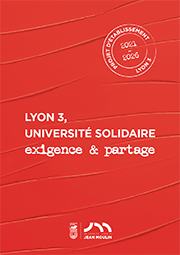AccueilRechercheProgrammes et productions scientifiquesThèsesThèses soutenuesThèses soutenues - 2006-2021Thèses soutenues - 2013
-
Partager cette page
- Recherche,
JAMPY Marc
Expériences de presse, Lyon, 1870-1914
Publié le 12 avril 2013 – Mis à jour le 28 ao?t 2013
Thèse en Histoire - Histoire religieuse, politique et culturelle soutenue le 11 avril 2013
Cette thèse est héritière de l’histoire de la presse qui s’est d’abord intéressée aux journaux puis aux journalistes. Cette étude, des journaux et en parallèle des journalistes, vise à combler un vide sur le journalisme de la presse périodique. Elle s’intéresse à la période 1870-1914, et analyse de fa?on critique ce qui est considéré comme l’?ge d’or de la presse. Ce travail s’appuie sur des archives inédites, notamment les rapports de police qui ont été rédigés régulièrement sur les journaux et journalistes de Lyon à cette époque. En effet, si les contraintes politiques sur la presse diminuent, notamment avec la loi sur la liberté de la presse de 1881, la surveillance continue à Lyon. La liberté de la presse, avec les progrès techniques, l’alphabétisation, l’urbanisation, la publicité expliquent la hausse du nombre de journaux, de leur tirage et du nombre de personnes qui se rattachent à ces journaux. 1 725 titres parus durant cette période ainsi que 1130 individus ont été recensés. Ces journaux sont des plus divers par leur périodicité, leur tirage et leur sujet, des quotidiens, aux journaux militants, religieux, de loisirs, professionnels. Mais ils répondent tous à un nouveau besoin d’informer et d’être informé, de médiatisation. Ils ont aussi en commun d’être lancés par des jeunes hommes issus de la classe moyenne. Cette expérience permet à certains de devenir journalistes de quotidien et de conna?tre une ascension sociale à travers les duels, les décorations et l’appartenance à une association de journalistes. Pour la quasi-totalité d’entre eux cela reste cependant une expérience éphémère qui dure quelques semaines.
This doctoral thesis is in line with the history of the press which originally focused on newspapers and later on journalists. The research aims at filling a gap of information on the journalism of periodicals by studying newspapers and journalists simultaneously. It focuses on the years 1870-1914 and provides a critical analysis on the era which is often considered as the Golden Age of the press. The author’s work relies on archives that had not been exploited before, in particular on police reports dealing with journalists and newspapers, which were then made on a regular basis. Indeed, although political pressure on the press diminished after the 1881 freedom of the press act was passed, police surveillance remained active in Lyon. Freedom of the press, as well as technical progress, a higher literacy rate, urbanization and the rise of advertising account for an increase in the number of newspapers, their circulation and contributors. 1725 newspapers and 1130 journalists have been listed. Those newspapers varied in periodicity, circulation and topics, ranging from the daily to the activist, the religious or professional. However, they all fulfilled a new need to inform and be informed, of media coverage and they were all launched by young men from the middle class. The experience of journalism allowed some of those young men to become journalists in daily newspapers, to climb the social ladder by fighting duels, getting decorations or joining association of journalists. And yet, for most of them, journalism remained a short-lived adventure of a few weeks only.
Mots clés : Journalistes Journalisme Journaux Presse Imprimerie Publicité
Key words : Journalists Journalism Newspapers Press Printing advertising
Directeur de thèse : Olivier FAURE
This doctoral thesis is in line with the history of the press which originally focused on newspapers and later on journalists. The research aims at filling a gap of information on the journalism of periodicals by studying newspapers and journalists simultaneously. It focuses on the years 1870-1914 and provides a critical analysis on the era which is often considered as the Golden Age of the press. The author’s work relies on archives that had not been exploited before, in particular on police reports dealing with journalists and newspapers, which were then made on a regular basis. Indeed, although political pressure on the press diminished after the 1881 freedom of the press act was passed, police surveillance remained active in Lyon. Freedom of the press, as well as technical progress, a higher literacy rate, urbanization and the rise of advertising account for an increase in the number of newspapers, their circulation and contributors. 1725 newspapers and 1130 journalists have been listed. Those newspapers varied in periodicity, circulation and topics, ranging from the daily to the activist, the religious or professional. However, they all fulfilled a new need to inform and be informed, of media coverage and they were all launched by young men from the middle class. The experience of journalism allowed some of those young men to become journalists in daily newspapers, to climb the social ladder by fighting duels, getting decorations or joining association of journalists. And yet, for most of them, journalism remained a short-lived adventure of a few weeks only.
Mots clés : Journalistes Journalisme Journaux Presse Imprimerie Publicité
Key words : Journalists Journalism Newspapers Press Printing advertising
Directeur de thèse : Olivier FAURE
Membres du jury :
Claire BLANDIN, Maitre de conférences, HDR, Université Paris Créteil Val de Marne
Christian DELPORTE, Professeur, Université de Versailles Saint-Quentin-en-Yvelines
Dominique KALIFA, Professeur, Université Paris 1 Panthéon-Sorbonne
Marc MARTIN, Ma?tre de conférences honoraire, Université Paris Ouest Nanterre La Défense
Olivier FAURE, Professeur, Université Jean Moulin Lyon 3
Président du jury : Dominique KALIFA
Mention : Très honorable avec les félicitations du jury
Equipe d'accueil : LARHRA
Documentation
Mise à jour : 28 ao?t 2013







